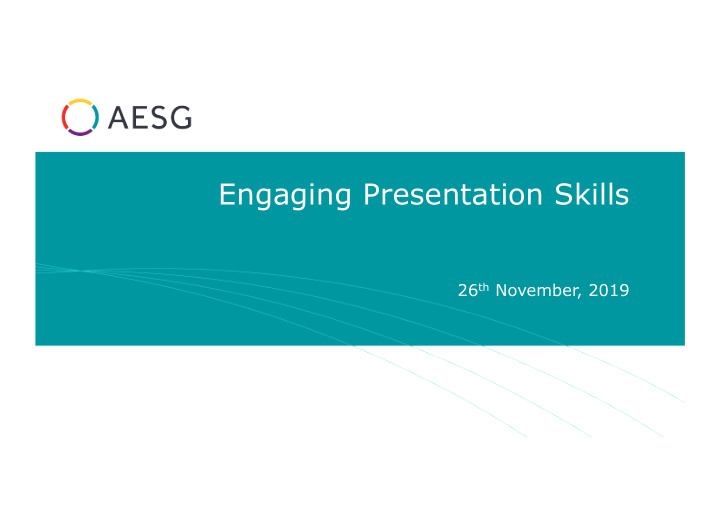



Engaging Presentation Skills 26 th November, 2019
Engaging Presentation Skills Contents Purpose of a presentation • Types of audience • Motivating Factors • Presentation methodologies • Steps of a presentation • How to make effective presentations • Telling a story • Promote activities and interaction • Overcome fear of presentation • Common mistakes to avoid •
Purpose of a presentation Communicate your Share goals and strategy and objectives discuss change Convince potential Provide training and investors motivation
Types of audience Professionals: demanding, practical, focused, need facts Students: dynamic, restless, open minded, easily bored
Types of audience Crowds: broader interests, need more energy and body language Clients: profit and time focused, non technical
Steps of a presentation ANALYSE YOUR AUDIENCE SELECT A TOPIC DEFINE THE OBJECTIVE PREPARE THE CONTENT DELIVERING & CLOSING
Types of presentations Instructional Informative Motivational Designed to build interest and • Brief and to the point Gives specific directions or orders • • emotions Describes facts Teaches something new • • Involves powerful language • Prioritises topics Long and thorough • • Uses stories or real-life examples • University lectures/research results Tutorial classes, safety • • Describes solutions to problems demonstrations • https://www.slideshare.net/jimaspinall3/types-of-presentations
Types of presentations Decision-making Persuasive Visual Aimed at large audiences with To win listeners’ buy-in To convince about a decision • • • broad interests Shows strong supporting facts Describes issues to find solutions • • Requires strong public speaking • Highlights advantages and Presents predictions and scenarios • • skills opportunities Government policy meeting, bank • More efforts to keep the audience • Political debates, business proposals business meetings • engaged https://www.slideshare.net/jimaspinall3/types-of-presentations
Activities and Examples – Questions? Think of different audiences and how your presentation will change v Consider pros and cons of different presentation methods v List challenges of situations where very different audiences attend the v same presentation, e.g. a stakeholder meeting Describe your experience in doing presentations v Self assess your skills and try to suggest improvements v
The Learning Pyramid The percentages represent the average In order to make sense of what we "retention rate" of have learned, any new information information following we receive needs to be 'digested', teaching or activities not just memorised. by the method indicated. Problem-Based Learning: Exploiting Knowledge of how People Learn to Promote Effective Learning, Wood E J, 2004.
Motivating Factors v Social Relationships: to make new friends, to meet a need for associations and friendships. v External Expectations: to comply with instructions from someone else; to fulfil the expectations or recommendations of someone with formal authority. v Social Welfare: to improve ability to serve mankind, prepare for service to the community, and improve ability to participate in community work. v Personal Advancement: to achieve higher status in a job, secure professional advancement, and stay abreast of competitors. v Escape/Stimulation: to relieve boredom, provide a break in the routine of home or work, and provide a contrast to other arduous details of life. v Cognitive interest: to learn for the sake of learning, seek knowledge for its own sake, and to satisfy an inquiring mind.
How to make effective presentations Make a strong Focus on a core Connect with the entrance message audience https://www.businessballs.com/communication-skills/presentation-skills-and-techniques/
How to make effective presentations Share your Keep it simple Relax and have fun! enthusiasm
Engage the audience by telling a story Focus on characters and events who are involved in the topic of the presentation. Provide a different “observation angle” including examples of fun, humour, interest, participation and diversion. Create analogies and themes, using content and activities to stimulate feelings, emotions, memories and even physical movement. Provide dynamic real life examples or possible scenarios.
Promote activities and interaction Ask someone to get on stage with you Create groups and give them tasks Activities increase creative thinking and Get people to move out-of-the-box Group activities around a bit ideas promote selective Play games – ask questions attention and listening Ask people to share their experience
Overcome fear of presenting Also called “glossophobia”, or fear of public speaking, can hamper your speaking efforts. Some useful tips: 1. Think of communication, not performance 2. Focus on the core message – put passion in it (pick a subject you care about) 3. Be present in the here and now – focus on the material, not the audience 4. Rehears and prepare beforehand 5. Do breathing and tension release exercises, like meditation 6. Mingle with listeners and chat with them 7. Take public speaking classes (or theatre…..or singing classes…) 8. Take breaks or sip water from time to town 9. Make your nervous energy work for you https://www.briantracy.com/blog/public-speaking/27-useful-tips-to-overcome-your- fear-of-public-speaking/
Common mistakes to avoid 1. Not tailoring your message to your audience. 2. Not maintaining eye contact. 3. Distracting mannerisms. 4. Low energy. 5. Not rehearsing. 6. Data dumping. 7. Not inspiring. https://www.businessinsider.com/avoid-these-public-speaking-mistakes-2016-2#-7
Activities and Examples – Questions? Make groups and discuss your experience v Share how you have or plan to resolve fear of presenting to group v members who have experienced it Explain how you have been successful in delivering presentations in v the past – what is your secret? Have you had similar “stage performance” experiences – e.g. theatre v play, music concert - and what have you learned form them?
Thank You www.aesg-me.com
Recommend
More recommend